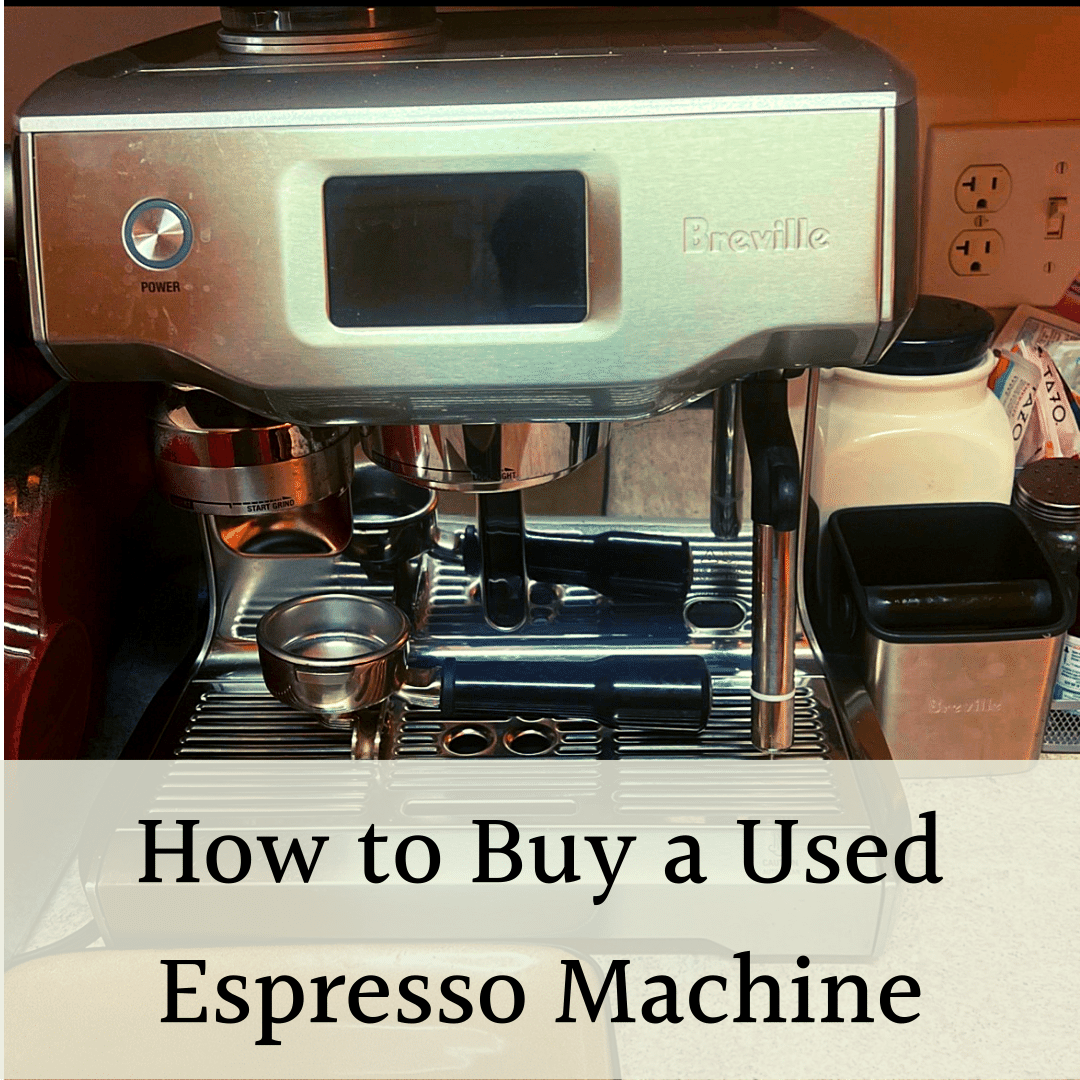One of the more subjective questions in espresso: should you get an espresso machine with an integrated grinder, like the Barista Express, or an espresso machine without a grinder, like the Breville Bambino?
I recommend the Breville Bambino because it packs a punch: newer heating system, better steam wand, and it works great with a Baratza Encore ESP grinder at a very reasonable price. You can also use the Barazta grinder for filter coffee!
That said, the built-in grinder makes the Barista Express easier to use. Get the Barista Express for simpler mornings, or even better, consider another Breville Barista model.
Here’s your guide to choosing the Breville Bambino vs Barista Express. Whether you’re a budding barista or a seasoned espresso enthusiast, I’ll explain which choice is best for you.
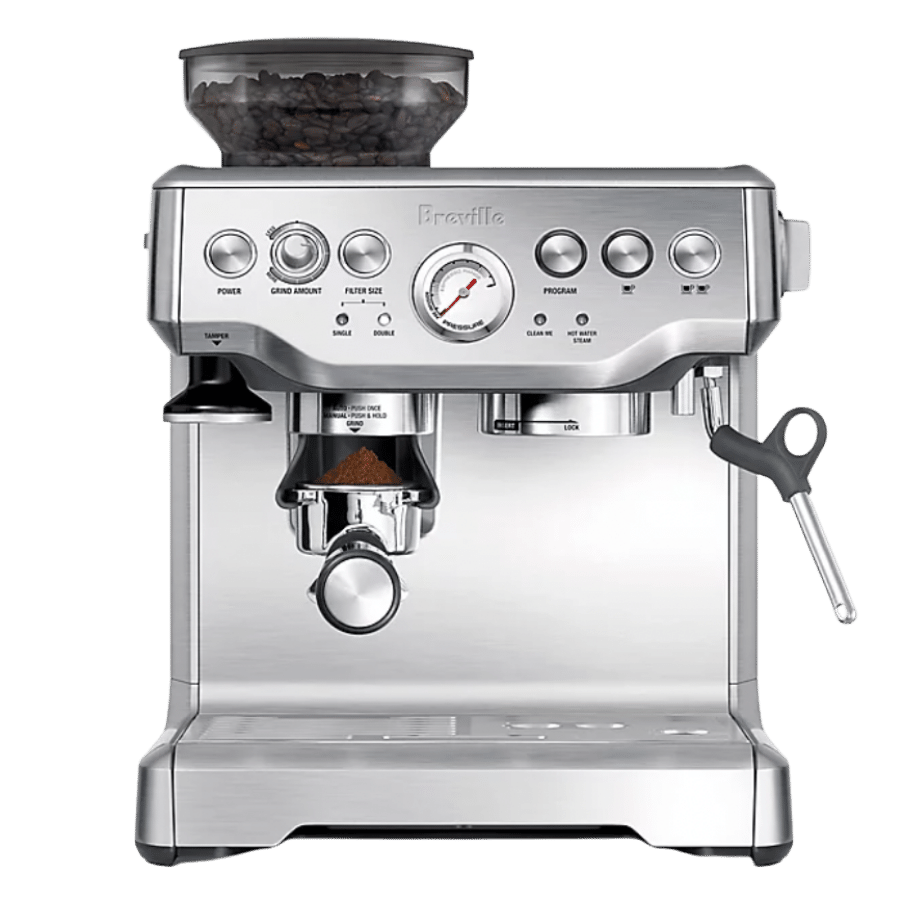
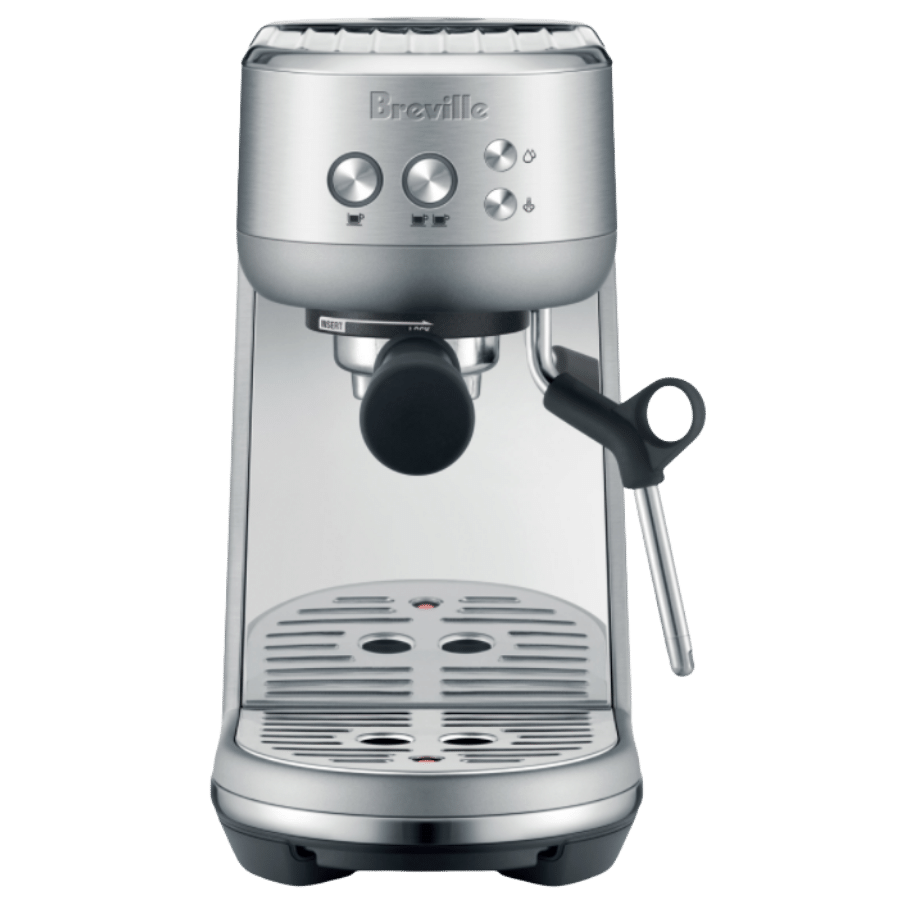
Feature Comparison
I’ll go through the most important differences in order.
Integrated Grinder Or No Grinder (Ease of Use)
Breville Barista Express is a true all-in-one espresso machine, as it comes with its integrated grinder design, offering a seamless coffee-making experience. The integrated grinder is THE biggest difference between Barista Express and Bambino, which doesn’t have a grinder.
The Barista Express has a 40mm conical burr grinder that is calibrated for espresso with 16 different settings. It’s built into the machine, and you can lock in your portafilter, give it a press, and the Express doses right into your portafilter.
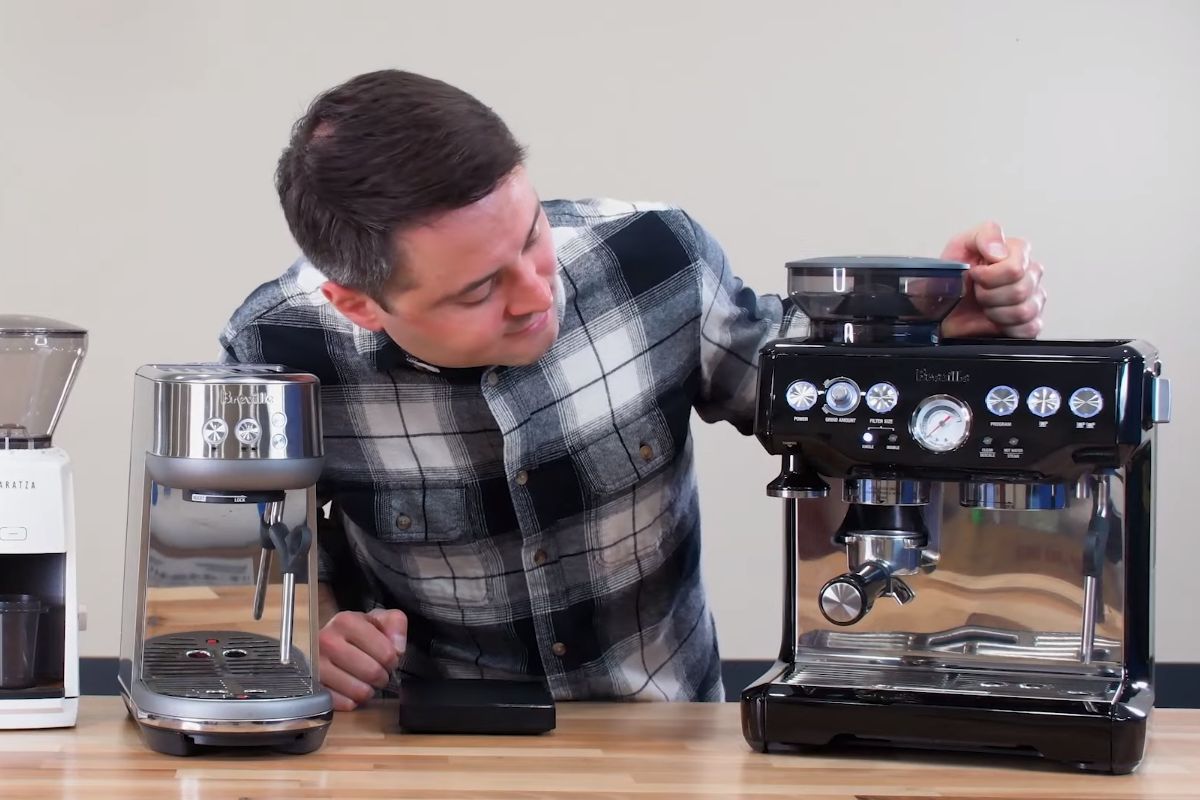
This “hybrid” style of integrated grinder adds a level of simplicity that has made the Breville Barista Express famous. A home barista gets the same level of control as a cafe with one machine.
The integration makes the workflow simple. Once the coffee is ground, tamp the portafilter and lock it into the brew head to pull a shot. The Barista Express has a simple grind dial to adjust fineness, and it doses based on time, so you get the same volume.
However, the built-in grinder has some downsides. For starters, the grind consistency doesn’t match standalone espresso grinders. It’s easy to find a better grinder than Brevilles…It spits out a lot of clumps that require a WDT tool.

Also, the grinder on the Barista Express has 16 settings, which isn’t enough for espresso. For comparison, I used hand grinders with over 400 settings.
Don’t get me wrong; it’s not all bad. The cradle snugly holds the portafilter in place, allowing for hands-free grinding. This not only adds to the convenience but also minimizes mess, as the grounds go directly into the portafilter. Additionally, the drip tray is thoughtfully designed, as it collects any stray coffee grounds, keeping your workspace neat.
Finally, the machine’s single outlet further simplifies the process, making it a dream for those who value straightforward, efficient operation. It’s much simpler than my kitchen coffee setup.
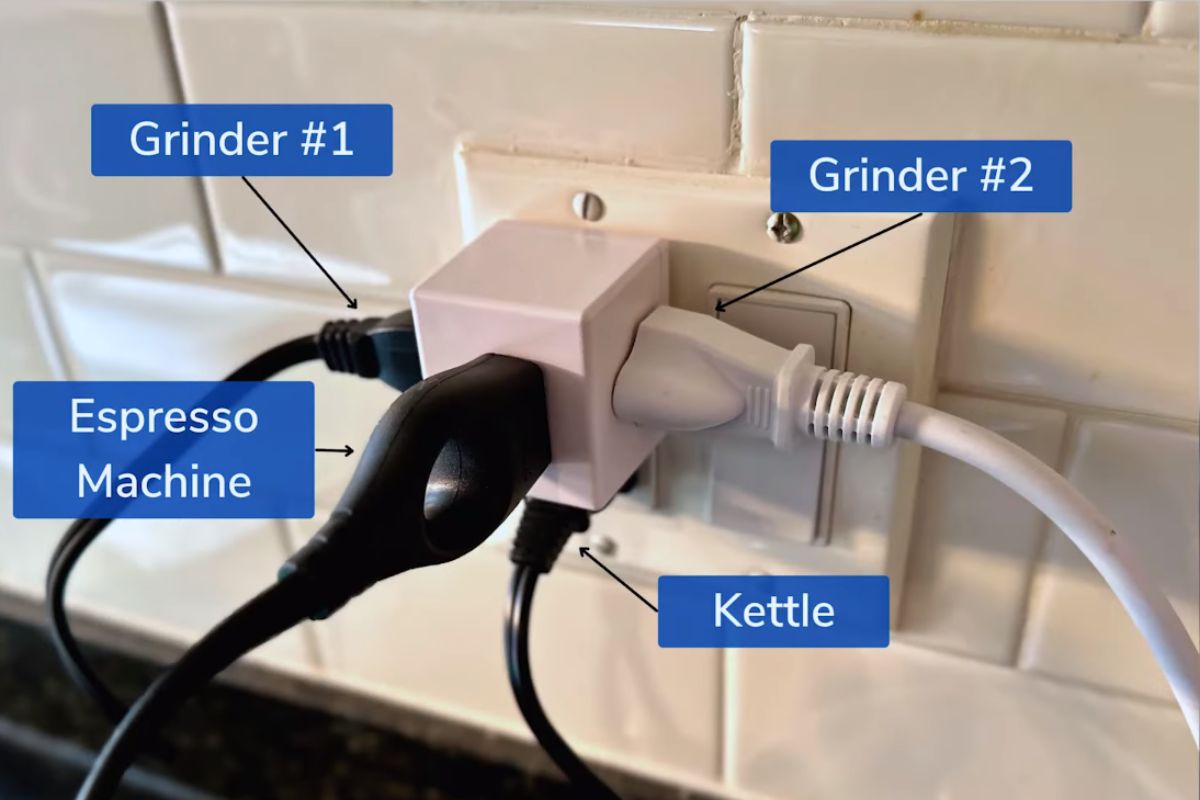
Essentially, the Breville Barista Express is easy to use and a good starting point, but you’ll probably upgrade the grinder as your barista skills grow.
Separate Grinder For The Bambino
On the other hand, the Bambino’s lack of a grinder leads to some interesting differences. First, the machine is smaller and fits tighter spaces.
Then, there’s the obvious: you need to buy a separate grinder. Remember, we’re grinding for espresso, which requires a specialized grinder. Don’t go buying a blade grinder or the cheapest thing on Amazon. There’s an old saying in coffee: spend more on your grinder than the machine.
The nice thing is buying a standalone grinder opens up a world of possibilities. You can get something like the Baratza Encore ESP, which is comparable to the Barista Express grinder and grinds for various brewing methods beyond espresso. You also save a lot by using a Bambino and Baratza compared to a Barista Express.
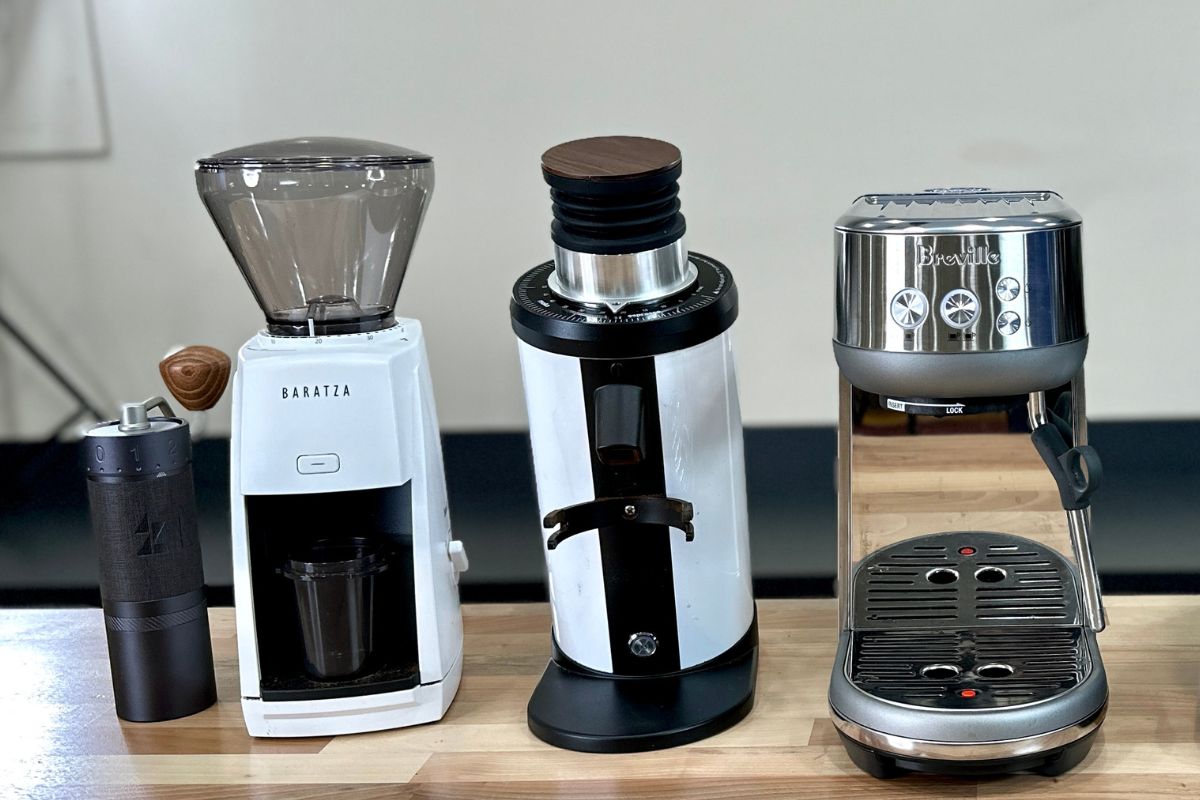
You can go further by getting a true espresso grinder, like the DF64, which can blow away the Barista Express in terms of quality at a similar combined cost. So, you can definitely do better by buying the grinder separately.
However, it is harder to use a separate grinder. For example, the Baratza Encore ESP doesn’t have time-based dosing, so you need to weigh out your beans with a scale every morning. Also, you have to transfer the beans to the portafilter.
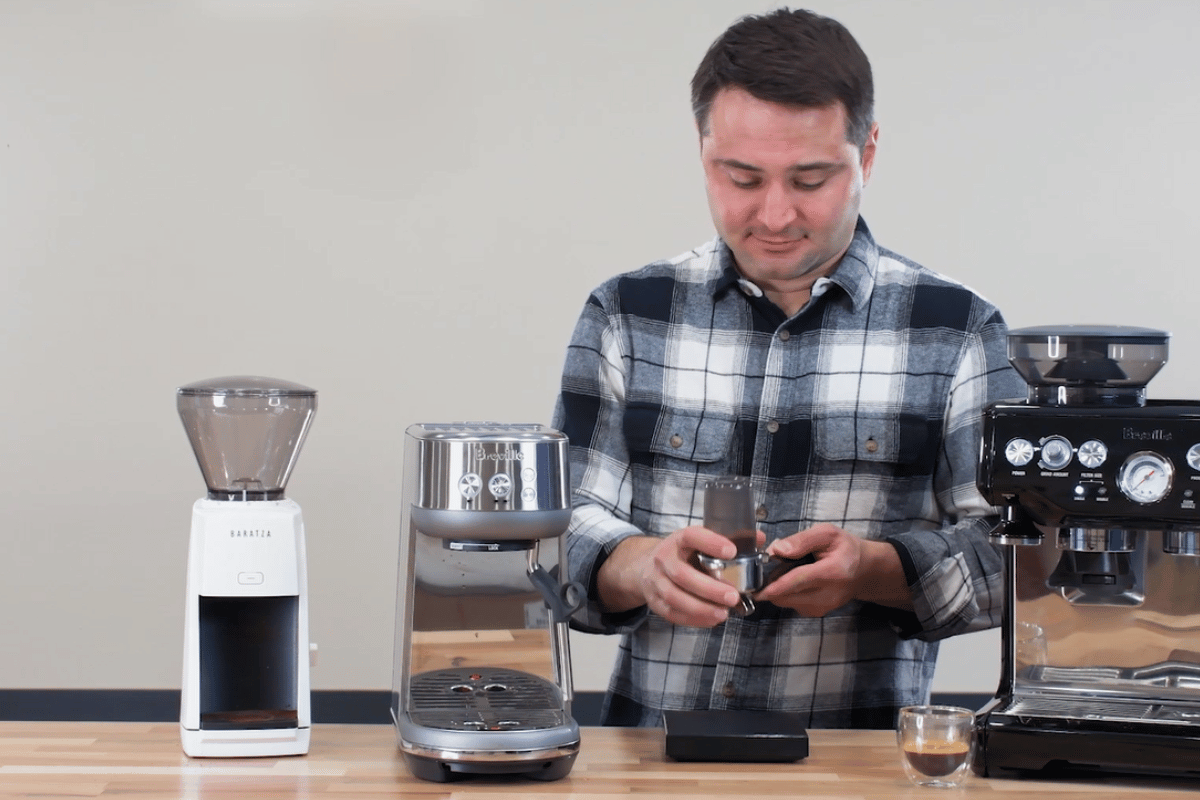
This messy process gets harder with premium espresso grinders since they’re rarely designed for Breville’s smaller 54mm portafilter.
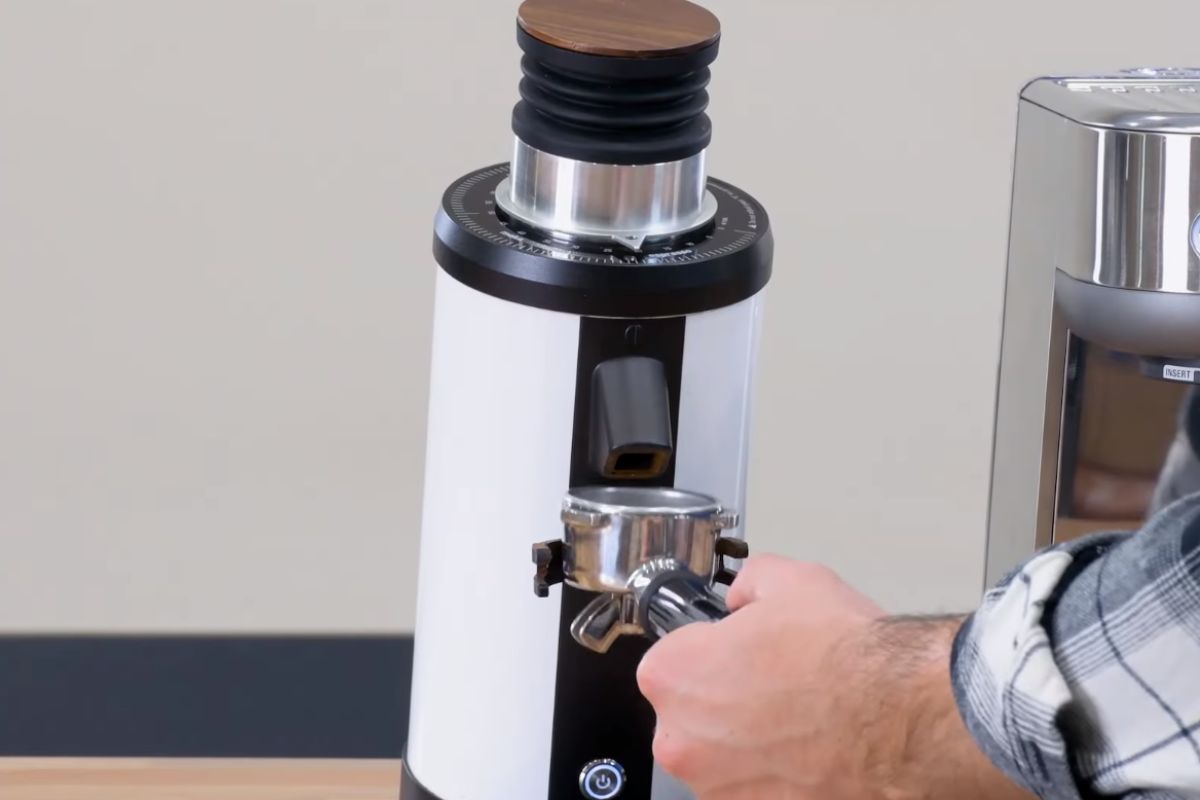
Personally, I recommend a Bambino and a separate grinder, since it’s less expensive, opens up more choices, and can improve quality. The Baratza Encore ESP is a great starter pairing; you’ll get used to the process.
Otherwise, the Barista Express grinder is solid and easy to use.
Espresso Performance
Aside from the grinder, the Breville Bambino makes better espresso than the Breville Barista Express. Several key factors come into play, notably the heating systems, pressure capabilities, and customizable settings.
Heating Systems: Thermocoil vs. ThermoJet
Good espresso is about consistent water temperature at 200 degrees F (93 C), which depends heavily on the internal heating system. The Barista Express uses an older Thermocoil heating system, which is less consistent.
I noticed the Express gets very hot after pulling back-to-back shots. Also, you’ll hear a “growl” as the Express purges water in the drip tray to avoid overheating. This temperature instability leads to a sharp espresso taste on the Express, with bitter and sour notes.
The Bambino, on the other hand, uses the ThermoJet heating technology. This system is known for its quick heat-up time (only three seconds), making it a great choice for those short on time but still craving a quality espresso shot.
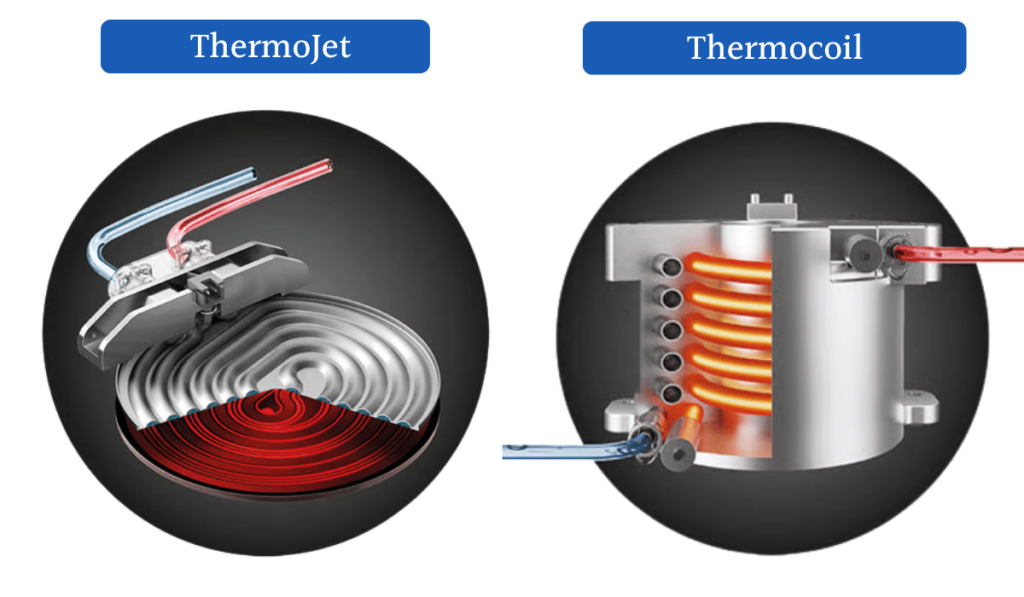
More importantly, I find the ThermoJet has better temperature control. The espresso tastes smoother when compared to the Express using the same grinder. The only downside is you need to run some water through the Bambino to pre-heat the ThermoJet since it’s actually too efficient.
Pressure Differences: High Pressure vs. Standard Pressure
The Barista Express runs at 14-15 bars, which is well above the standard 9 bars typically used in professional espresso machines.
The Bambino operates at a more traditional 10 bars, aligning closely with the industry standards which ensures a well-extracted espresso with good crema.

We’ve talked a lot about bars of pressure for espresso, and why higher pressure isn’t necessarily a good thing. For starters, it causes poor extraction. Too much force causes hot water to rush through the coffee.
Not only does high pressure cause poor extraction, but it makes the espresso machine hard to use. I found the Barista Express only has 2-3 usable grind settings; otherwise, espresso flows way too fast or not at all. This complicates my prior argument for ease of use on the Express.
Note: you can reduce the pressure on the Barista Express, which makes a big difference.
Customization: Water Temperature and Pre-infusion
Customization is where the Barista Express has an advantage. You can adjust the water temperature, which is an underappreciated tip for espresso brewing. Different beans and roast levels can benefit from slight temperature adjustments, so this feature lets you tweak and perfect your brew.
Moreover, the Barista Express lets you extend the pre-infusion time indefinitely. Pre-infusion is the process of gently soaking the coffee grounds before full pressure is applied, and it’s key to a balanced extraction.
This feature is particularly beneficial if you want to experiment with different extraction profiles or use specialty beans that benefit from a longer pre-infusion.
In contrast, the Bambino has a fixed pre-infusion time of 7 seconds. While this is generally adequate for a good-quality espresso, it doesn’t offer the same level of control as the Barista Express. You also can’t change the water temperature on the Bambino, although it still brews better espresso than the Express.
Milk Steaming
Both wands have a similar design, with a one-hole tip and flexible 360-swivel. However, the Bambino clearly wins the milk steaming competition. Its steam wand stands out due to its ThermoJet heating system.
The enhanced power of the ThermoJet translates to a 5-10 second start time for the steam wand. It has stronger steam pressure, and I finished frothing in one minute.
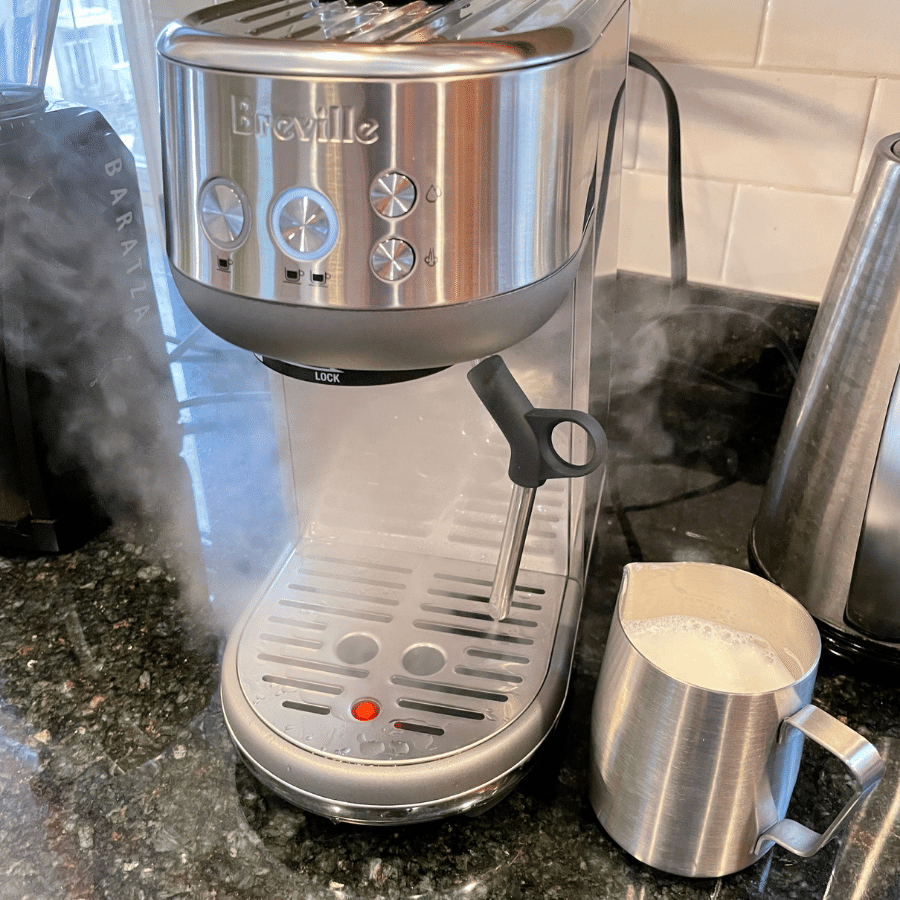
Meanwhile, the Barista Express takes longer to start. You’ll wait 10 seconds with nothing happening before it jumps to life and gains steam (pun intended). The Express takes 90 seconds to froth milk to 150 degrees F, longer than the Bambino.
All that said, the Express still makes a nice textured foam. It’s comparable to the Bambino, but it takes longer.
Automatic Milk Frothing Alternatives: Bambino Plus and Barista Touch
If you’re particularly passionate about milk frothing and are looking for even more convenience, the Bambino Plus and the Barista Touch are worth considering.
Both of these models come equipped with a temperature sensor in the base, which automatically stops frothing at the right temperature. It’s quite accurate, and both models have different texture settings to create either a creamy latte foam or a dense cappuccino foam.
This takes the guesswork out of milk steaming, making it easy to achieve consistently perfect milk texture and temperature every time.
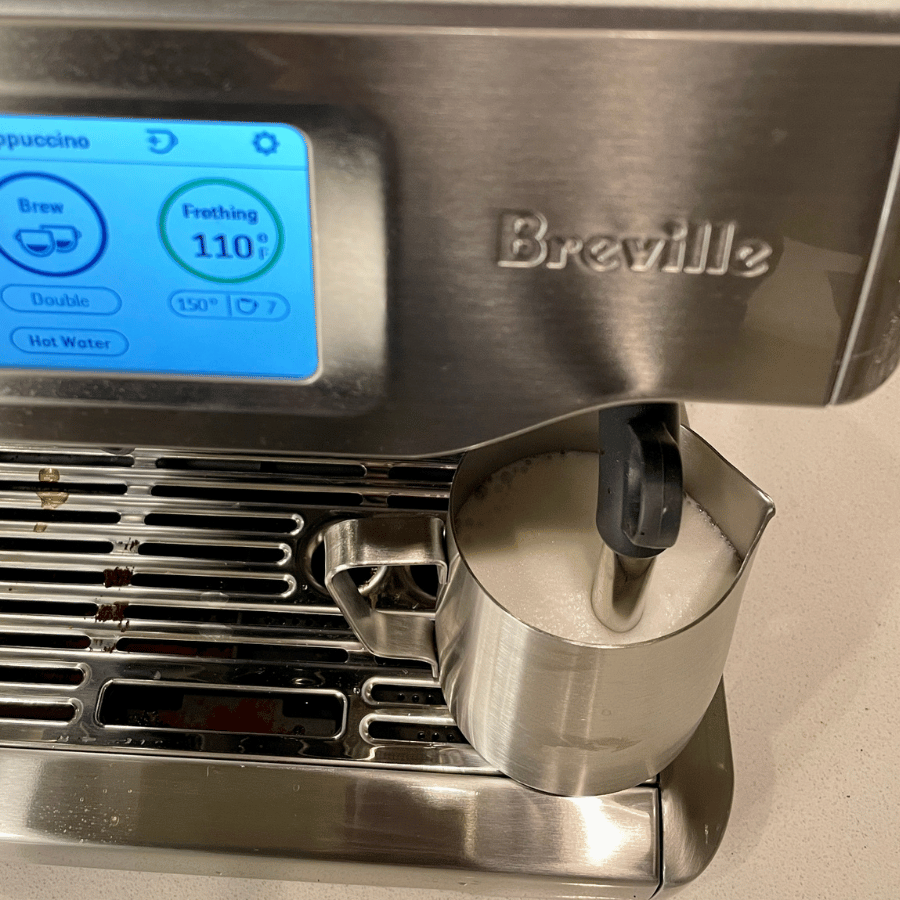
Personally, I recommend the Barista Touch if you have the budget, as it has more settings for texture and temperature, which is really nice. Also, the steam wand is partially insulated, which reduces burns and makes it easier to clean. You can read our whole review of the Barista Touch here.
Value
The Bambino offers great value for those who are looking for quality espresso.
While it lacks the integrated grinder and detailed customization options of the Barista Express, the newer heating system more than compensates for this. Even though you have to buy a grinder separately, a Bambino & Baratza Encore ESP are still less expensive combined.
Also, you can get more choices, as you can spend as much as you want on a high end espresso grinder like an Eureka Mignon. This added choice is the true value of this combination.
The Barista Express value comes from its ease of use. The integrated grinder makes it easier to get started with espresso. Remember, espresso has a serious learning curve and learning one appliance is easier than two.
Recommendation: Which Type Is Better
Deciding between the Breville Barista Express and the Breville Bambino depends largely on your priorities, budget, and how you like to enjoy your espresso.
If you’re working within a budget but still want to enjoy a high-quality espresso experience, pairing the Bambino with a separate grinder like the Baratza Encore ESP is an excellent choice. This combo is the most affordable way to beat Starbucks.
It also offers flexibility. The Baratza Encore ESP has coarser grind sizes for different brewing methods, not just espresso. This setup is ideal for those who appreciate both espresso and other coffee styles, which means you get great value and versatility.

The Barista Express is a fantastic option for those new to espresso making or prioritizing convenience.
It simplifies the brewing process without compromising the quality of the espresso (much). The Barista Express is designed for ease of use, making it a great choice for those who want to enjoy a quality espresso at home with minimal fuss.
Advanced Options: Barista Impress, Pro, and Touch
If you’re leaning towards the Express, I strongly recommend considering the other models in the Barista series, like the Express Impress, Pro, and Touch. These machines offer additional functionalities, such as more precise temperature control, enhanced steaming capabilities, and even more automated features.
Frankly, the Barista Express has gotten outdated. The Barista models have better features for those who enjoy the process of crafting the perfect cup and are worth the extra budget.
Breville Barista Express vs. Breville Bambino: Final Thoughts
Whether you choose the Breville Barista Express or the Bambino largely depends on your personal coffee journey. The Barista Express is ideal for beginners and those seeking an all-in-one, convenient espresso experience, while the Bambino, paired with a quality grinder, offers great value and flexibility for budget-conscious coffee enthusiasts.
You aren’t sold on these espresso machines? If you want to explore or invest more, check out our selection of the best Breville espresso machines. Each option caters to different preferences, ensuring that there’s a perfect Breville machine for every coffee lover’s needs and lifestyle.

